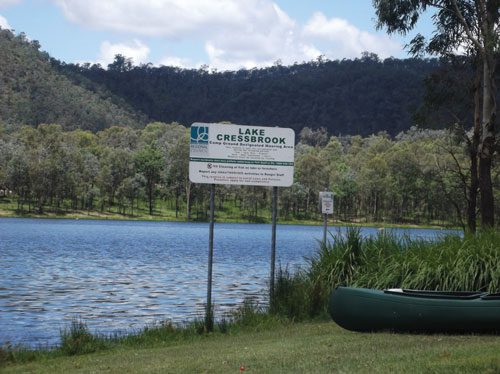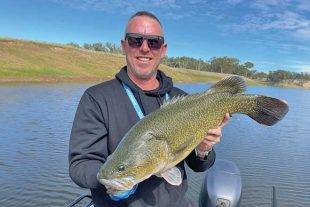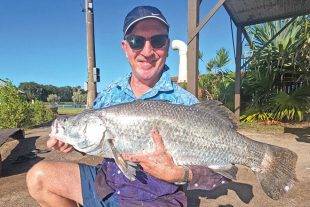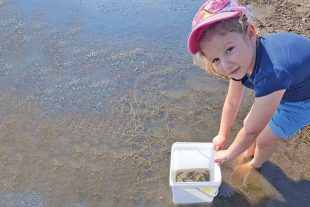Log cabins and synthetic trees are part of a successful trial of fish-attracting structures in Queensland, which could be the boon freshwater fishers have been angling for. Recreational fishing is meant to be about the journey.
You’re out in the elements, convening with nature and practising the kind of mindfulness people often pay good money for. But let’s be honest, there are only so many times you can wet a line and return home empty-handed before that journey becomes a chore.
For anglers on Cressbrook Dam – one of three drinking water reservoirs servicing Toowoomba in Queensland – catches have sometimes been few and too far between. It’s not that the fish weren’t there – Cressbrook is well stocked with golden perch and Australian bass.
But the dam stretches over 500ha, the hunting ground too spread out and the fish too hard to find. As for many artificial waterways or impoundments – water bodies built up behind dams – Cressbrook is an underwater desert.
Commonly, trees and other natural elements are cleared from areas to be flooded in order to protect the water quality. In the impoundments that retain trees, the timber naturally breaks down over 40 to 80 years. Cressbrook Dam was built in the 1980s.

A bare-bottomed dam.
Recent sonar mapping of the dam – carried out by a team from Queensland’s Department of Agriculture and Fisheries – confirmed that there were few underwater topographical features. This meant fish had few places to congregate for food and shelter – likewise anglers had limited options to focus their fishing efforts.
DAF researcher Andrew Norris said, “It’s very barren.”
“One of the reasons a lot of Australian dams are quite barren is their highly fluctuating water levels.
“And, as any remaining timber goes through a wetting-drying cycle, it breaks down quite quickly.
“In Cressbrook, there’s almost no standing timber at all.
“There are a couple of very small shrubs in one or two spots, but that’s it.
“It was a bare bottom with a few rocks and some aquatic vegetation around the edges.”
Andrew’s interest in reservoir fish habitats dates back to at least 2015, when a Churchill Fellowship grant had the Fisheries biologist driving across the US on an eight-week fact-finding mission.
Creating fish habitats
Unlike Australia where impoundment fisheries are primarily managed by stocking and harvest controls – bag and size limits – US fisheries managers have long been using a third and very effective tool… habitat enhancement.
Collaboration with the US managers and the Reservoir Fisheries Habitat Partnership provided a cache of unpublished information and internal reports from the US.
This led to the development of a report, which provided numerical evidence that the idea was worth trying in Australia. Fast-forward to 2018 and, together with funding from the Fisheries Research and Development Corporation and others, the DAF researchers began working on a strategic fish attracting plan with stakeholders and co-investors.
These included the Toowoomba Regional Council, the Toowoomba and District Fish Stocking Association, FRDC and Fisheries Queensland.
“The goal of the project was to demonstrate that fishing could be improved by putting habitat in, which then gives the fish the habitat they need, while also giving anglers a point where they can target fish,” Mr Norris said.
Three habitat trial
Using data and know-how gleaned from the US, the DAF researchers teamed up with local fish stocking groups and community volunteers to build three different types of habitats – timber, synthetic and suspended structures.
The timber fish attracting structures included brush bundles, branch bundles and porcupine cribs – miniature ‘log cabins’ made out of untreated hardwoods which, though less natural in appearance, tended to break down slower and have a longer lifespan than their brushy counterparts.
Synthetic FAS were made primarily out of water-safe inert PVC and other plastics constructed either in the shape of trees, ‘spiders’ or cubes.
Suspended FAS consisted of a floating buoy anchored to the bottom of the dam with a cable.
A large synthetic treelike structure was suspended on the cable with the top 2m below the surface. The suspended structure could rise and fall with the dam’s natural water level fluctuations.
“The actual structure itself is about 3m in diameter, 3m tall and consists of a main trunk with 34 branches inserted horizontally along it,” Mr Norris said.
The benefit of the floating design is that it stays in the highly oxygenated thermocline zone during summer.
“And that’s often an area where fish will hunt,” he said.
Monitoring results
A total of 576 structures were deployed across 25 sites within the dam. The team used a range of techniques to track fish populations, including underwater drones – not so effective due to turbidity – electro-fishing that temporarily stuns fish with an electric current, targeted angling and acoustic tracking.
Thirty golden perch and 30 Australian bass were monitored over two years. One monitoring technique suggested the timber was working better and one suggested the synthetic structures were.
“Essentially, they’re on par,” Mr Norris said.
“And that’s important, because in some waterways, particularly town water supplies, the waterway managers may not let you put timber in because it can have a very small amount of leeching that some councils think it might affect water quality.”
Despite reduced fishing following the 2019 bushfires, the pandemic and recent floods, those anglers who were surveyed during the trial reported improvements to catch rates and an increase in visitation.
Best practice guide online
With guidelines now available on the Department of Agriculture and Fisheries and FRDC websites, fish stocking groups and fishery managers around Australia can run through best practices, step by step.
“We’re already getting phone calls and emails from people in Victoria, NSW and all over Queensland,” Mr Norris said.
“A lot of people were very interested in this project and the results.”
Andrew is proud of the team’s work and is confident it will have a significant and positive impact on freshwater angling in Australia – and therefore regional tourism – in the years ahead.
“We’re very happy with how things have turned out,” he said.
“And we certainly hope that the community gets the benefit of the results of this. “The project provided a great example of what can be achieved when community groups and all three levels of government cooperate and work towards a common goal.”








